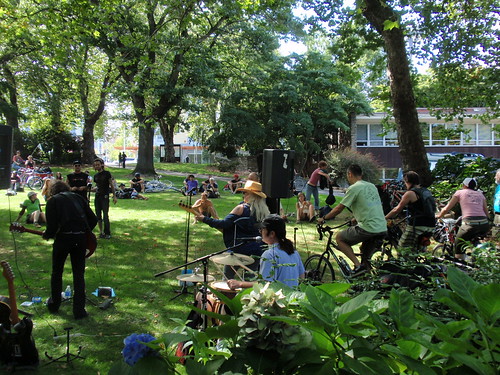Parks as order vacuums or not: Seattle

Seattle Bicycle Music Festival, Denny Park. Flickr photo by Velo abzug.
The Seattle Times has an article, "Old Denny Park gets new life with growth of South Lake Union," on the resurgence of Denny Park, which has been improving both because of physical improvements as well as an influx of new users as the South Lake Union district revitalizes, adding more resident population as well as office buildings, which contribute more in the way of daytime visitation to the park.
I can't find my copy of Death and Life of Great American Cities at the moment, but there is discussion there about parks and how when they are big parks set off to the side so to speak, they don't get used.
Parks that don't get used "legitimately" in the urban context become opportunities for order vacuums. The ST article discusses how Denny Park was a negative, not a positive, public asset not that long ago:
It's a far cry from the scene here not long ago, notes Dewey Potter, spokeswoman for Seattle Parks and Recreation. Sure, you will still see people reposing on the grass here and there for what looks to be more than an occasional nap on a stolen afternoon.
But there are no encampments here, no sense anymore of the takeover of this public space by drug dealing and prostitution so brazen that park staff used to observe the goings on through the windows of the administration building.
"The police were here all the time, there was a lot of illegal activity in the park and it wasn't a place where people came just to be," Potter said. "The park didn't get a lot of use, which is too bad because it is one of the most beautiful parks we have."
2. I remember a quote from a NYC parks official serving during the Lindsay Administration, commenting that someone who destroys a park bench in a public park is just consuming the park differently, and not taking a stand against the destruction of the park.
Of course, those kinds of attitudes contributed to the precipitous decline of center cities across the country.
One reason you may see a lot of broken glass in playgrounds and parks in troubled areas is that nefarious types break the bottles because the broken glass discourages legitimate users. No parent is going to want to bring their child to a playground that is littered with broken glass... so then the playground becomes a good place to sell drugs. (Also see "Brooklyn Park Glass," a blog entry from Broken Window about picking up broken glass in Fort Greene Park. They picked up 50 pounds of glass in two hours. Also "Park in Fort Greene is anything but" from Brooklyn Paper.)
3. Many years ago on an e-list discussion about pedestrian malls, the point was made that "plants don't activate spaces, people do," making the point that without lots of patronage, pedestrian malls can be forlorn empty places. This point is extendable. Great places can't be great without people.
Parks don't have to be huge, but they have to be used, in order to be successful.
Park success is shaped by location, size, facilities and amenities, programming, and management. All are necessary components of successful parks.
4. For the last year or so, I have been adding links in the right sidebar to a section entitled, Parks, Waterfronts, & Rivers Planning.
Some links that I added yesterday include:
These links are all associated with Green Places Magazine, to which the Catholic University Architecture Library has a subscription.
It's a superb publication from the United Kingdom, we have no equivalent in the US. It's about public spaces, parks, and landscape architecture, but very much practically focused. Every issue is full of great ideas and projects.
Labels: civic engagement, parks planning, public realm framework, public space management



1 Comments:
This comment has been removed by a blog administrator.
Post a Comment
<< Home